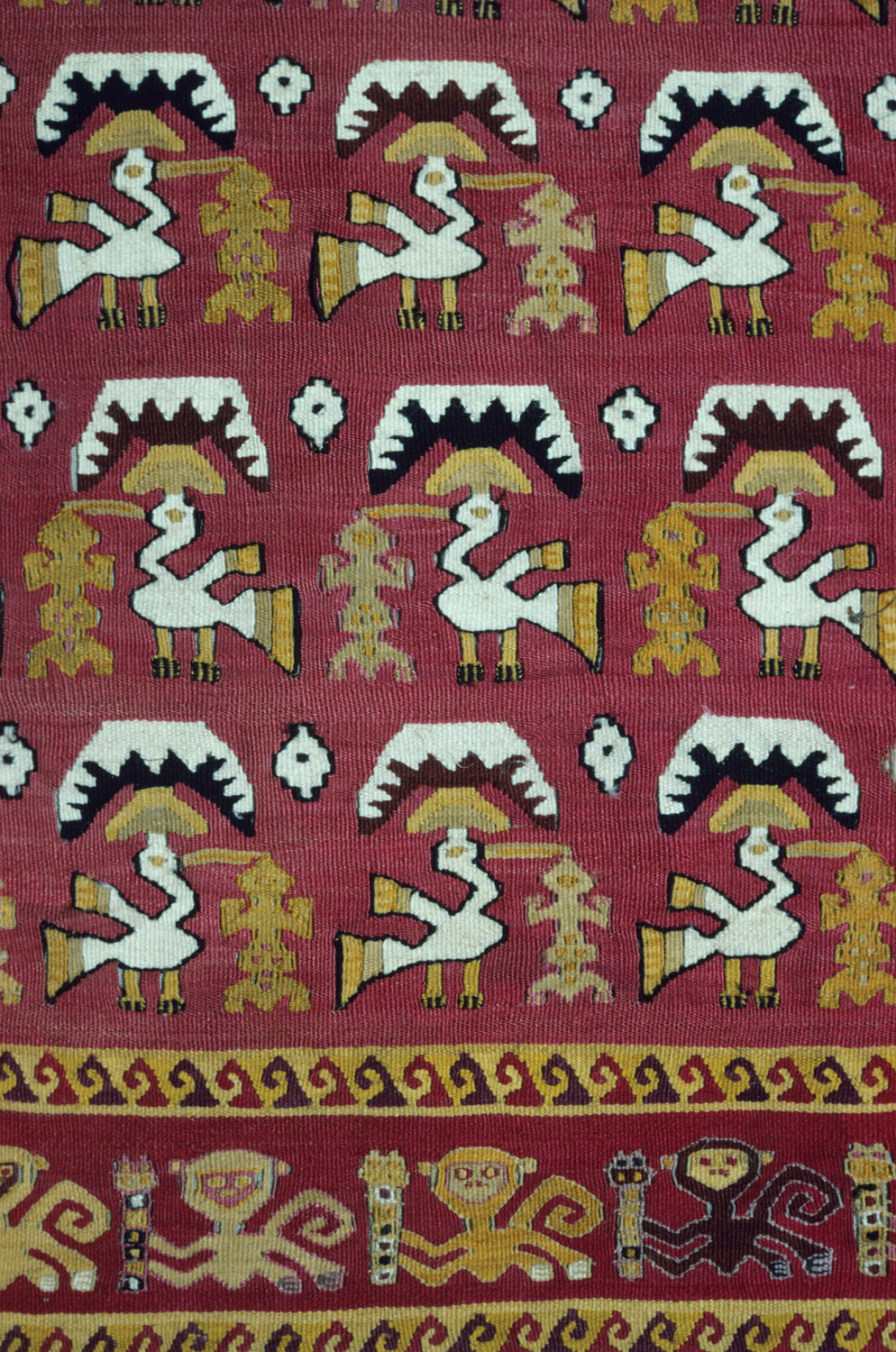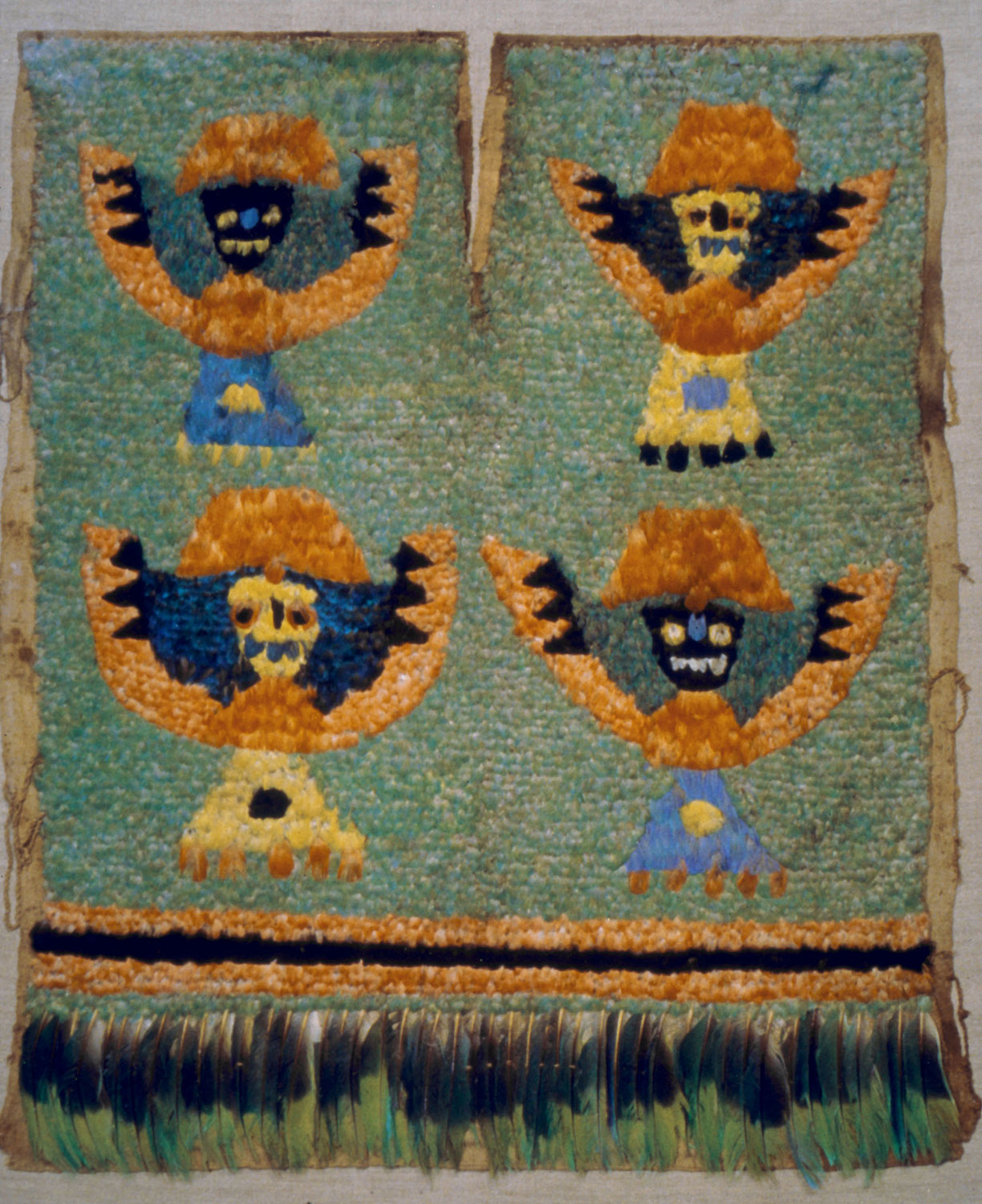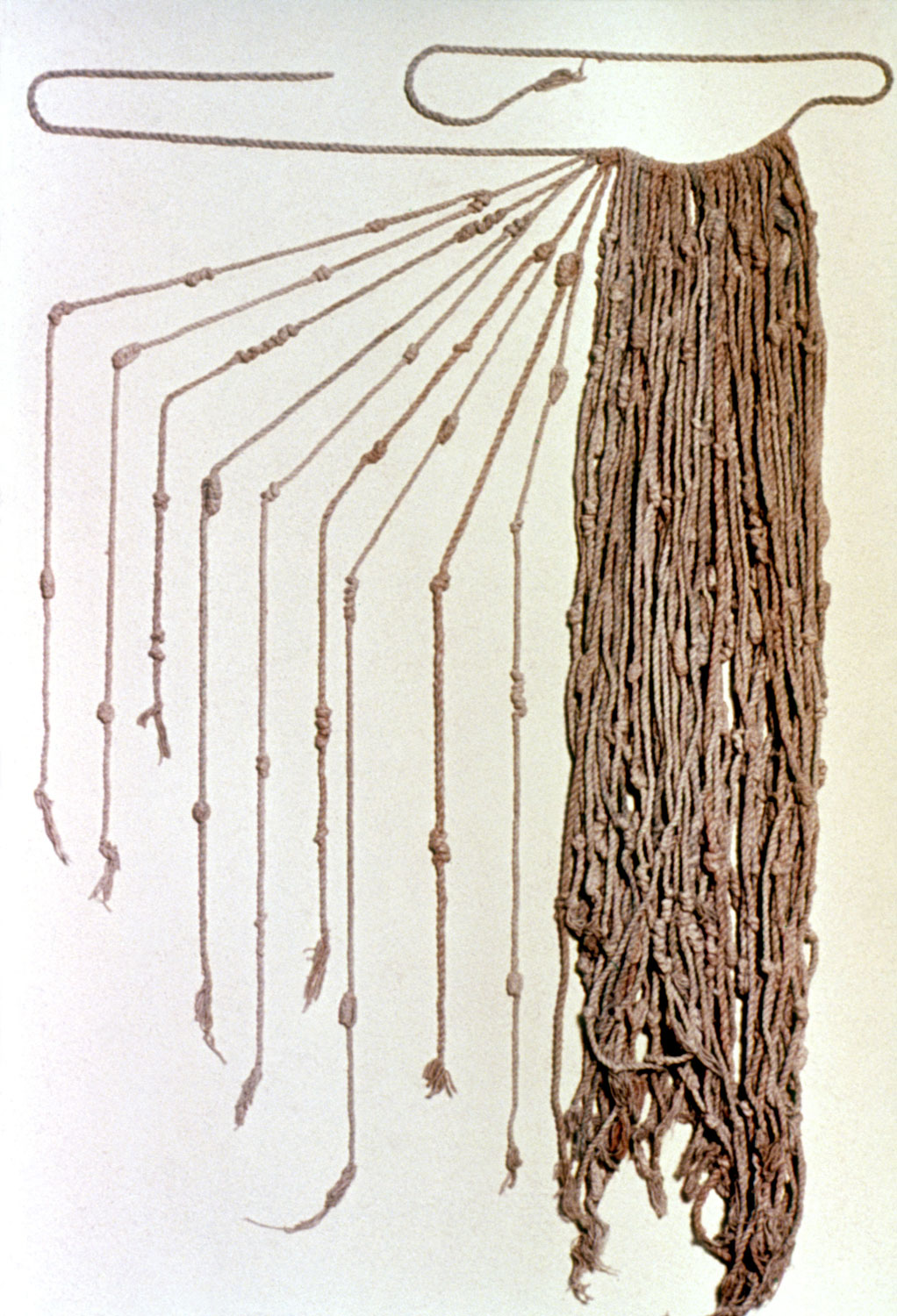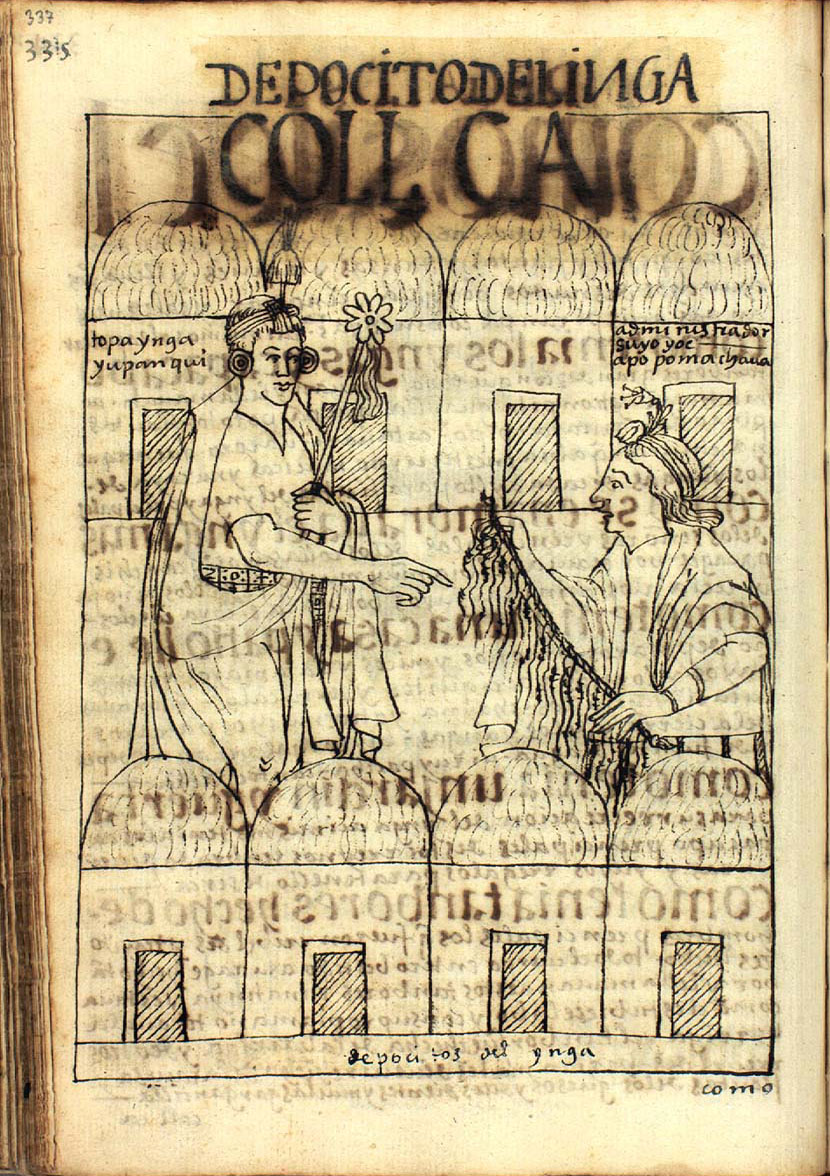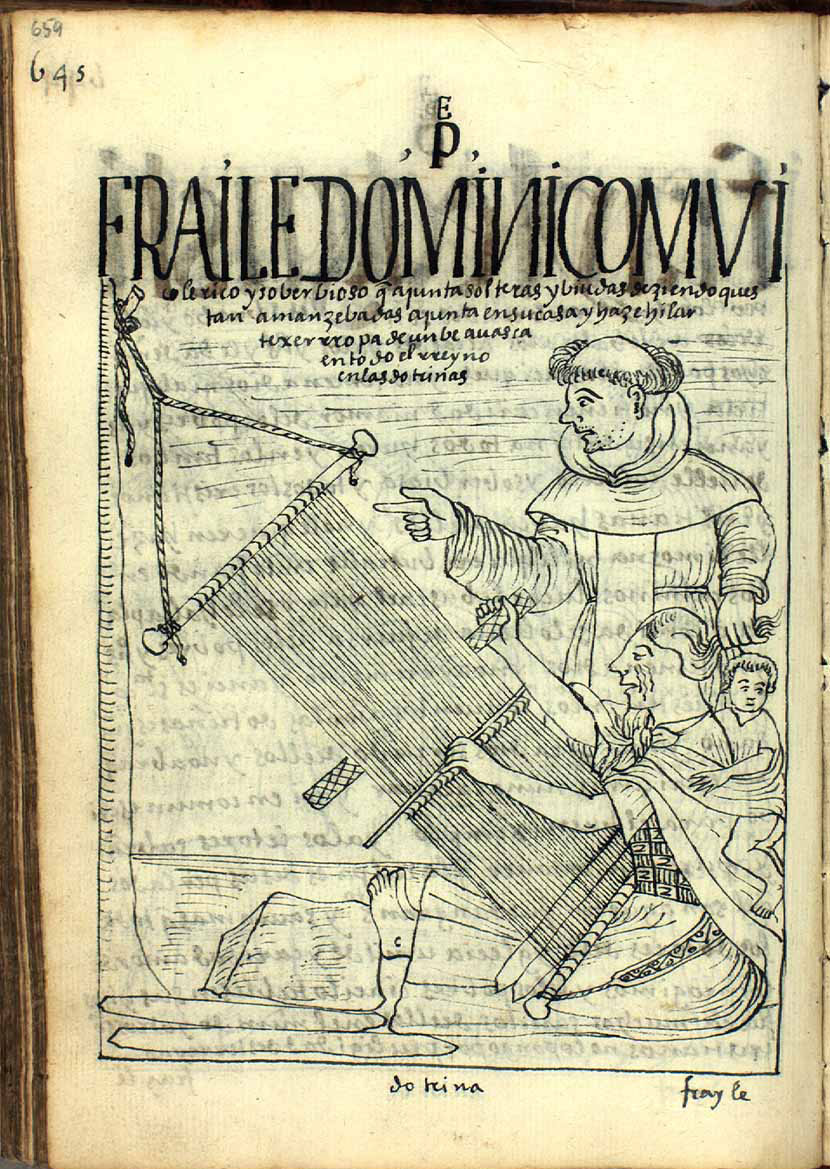The year is 1450 CE. A messenger chewing coca leaves for energy is hurrying down a well-paved road in the Andes, delivering tribute and records from a distant corner of the Incan Empire to officials at the capital. Both the tribute and records are made of woven cloth. The tribute--a symbol of a provincial potentate's fealty to the emperor--consists of several intricate textiles that represent the cosmology of the Incas and the central role of the emperor with geometric patterns, colors, and animal symbols. Some of these cloths will adorn civil and military elites, others may be burnt as religious offerings, and many will be used to clothe the revered and mummified dead. The official records contain information on the quantities of various stored goods, the services provided, and tributes paid. All of this data is stored in bundles of knotted strings, known as khipus, that will be stored at the capital for future reference.
Weaving held (and continues to hold) an unparalleled degree of importance among the indigenous peoples of the Andes, who have woven cotton since 2000 BCE and camelid wool by 1000 BCE, and textiles have been integral to the societies of all four major Andean polities (the Recuay, Huari, Tuwanaku, and Inca). The thread that the Incas spun was finer than most machines can do today and the immense amount of labor required to make a single textile was almost as important to its value as the end product (Rodman and Cassman 1995).
As with most other aspects of pre-Columbian societies, the Spanish conquest did much to alter both how woven goods were made as well as what they symbolized to Andean Indians. Khipus like those seen in the sources were burned by the thousands and the intricacies of their "woven" language has been forgotten. According to Karen B. Graubart, a historian of Latin America, the Spanish conquest even reshaped how Andean societies divided labor between men and women. Due to Spanish assumptions about gender roles and new demands for labor and textiles, weaving, once the task of both sexes (and sometimes even exclusively male), became relegated to the distaff and associated with low social status (Graubart 2000).
Despite the changes brought by the Spanish, homemade cloth remains central to the rituals, cosmology, and identity of rural populations in the Andes. Animal symbols and patterns, though changing with contemporary fashions and synthetic dyes, continue to reflect the structure of the universe and the dualism (e.g. between light and dark) that is a recurring theme in the Andean worldview (as in the source "Feather and Cotton Shirt"). Anthropologist Katharine E. Seibold held that these modern textiles express nativism, pride in their Incan heritage and its spiritual beliefs. She argues that it does not matter whether or not modern weaving actually is Incan in origin; what is important is that in the contemporary sense it is considered Incan, a way to identifying themselves with indigenous, not western, traditions (Seibold 1992).
Similarly, khipus are still actively preserved in a few Peruvian villages, although their meaning remains largely unknown. The difficulty, according to anthropologist Frank Salomon, is that the khipus are written in an inscribed language, one that does not relate directly to any actual spoken language and is entirely self-referential. Although the numerical system of many Incan khipus (explained in more detail in the sources) has been decoded, the stories they might tell are unknown (Salomon 2004).
The textiles and khipus symbolically weave order from chaos, a central element of Andean cosmology. Although globalization and the (post) modern world threaten Andean weaving practices, the indigenous peoples who continue to create, admire, and preserve these beautiful and meaningful items consider themselves part of an ancient and vital tradition, one that both expresses and embodies the universe and their place within it.
Questions for further exploration:
- Khipus have been the subject of much scrutiny and debate by recent anthropologists and historians, yet Spanish chroniclers in the sixteenth century made little effort to understand how they worked. What cultural assumptions led the Spanish of the early colonial era to disregard, indeed destroy, khipus? What cultural assumptions prompt modern scholars to scour them for meaning?
- Weaving, a technology practiced for over 4000 years in the Andes, still expresses and reproduces Andean culture and cosmology and is a source of pride both as a symbol of identity and a technological achievement. Modern technologies and sciences, such as nuclear power, physiology, and biotechnology, are also sources of pride for many Latin American countries. How is the social significance of weaving similar and different to that of these modern practices? Use this topic's sources and specific examples.
- What impact has modern technology, such as manufactured wool and synthetic dyes, had on textile culture in the Andes?
- What has been (and will be) the impact of the tourist industry on Andean textiles, both in terms of production and imagery?
Further Reading:
Brokaw, Galen. "The Poetics of Khipu Historiography: Felipe Guaman Poma de Ayala's Nueva coronica and the Relacion de los quipucamayos." Latin American Research Review. 38: 3 (October 2003): 111-147.
Graubart, Karen B. "Weaving and Construction of a Gender Division of Labor in Early Colonial Peru." American Indian Quarterly. 24: 4 (Autumn 2000): 537-561.
Heckman, Andrea M. Woven Stories: Andean Textiles and Rituals. Albuquerque: University of New Mexico Press, 2003.
Rodman, Amy Oakland and Vicki Cassman. "Andean Tapestry: Structure Informs the Surface." Art Journal. 54: 2, Conservation and Art History (Summer 1995): 33-39.
Salomon, Frank. The Cord Keepers: Khipus and Cultural Life in a Peruvian Village. Durham: Duke University Press, 2004.
Seibold, Katharine E. "Textiles and Cosmology in Choquecancha, Cuzco, Peru." In Andean Cosmologies Through Time: Persistence and Emergence. Eds. Robert V.H. Dover, Katharine E. Seibold, and John H. McDowell. Bloomington: Indiana University Press, 1992.
Urton, Gary. "From Knots to Narratives: Reconstructing the Art of Historical Record Keeping in the Andes from Spanish Transcriptions of Inca Khipus." Ethnohistory. 45: 3 (Summer 1998): 409-438.
